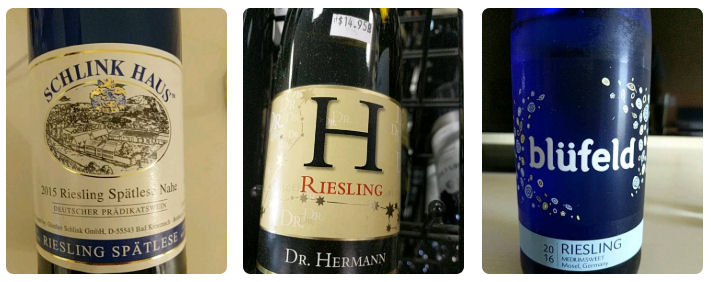Faced with a business trip to Texas — shudder — I opted to make the week a bit brighter by stocking up on some German rieslings to test against each other. I intentionally chose three budget reezies, each at $15 or less. These are readily available in the US, although would be treated as expensive “imports” if you try to get them in, say, South America. It’s nutty what I have to pay for a cheap riesling when I’m in Lima Peru.
The three Teutonic tipplers tasted were Dr. Herman “H” Riesling 2015 (Mosel), Blüfeld Medium Sweet Riesling 2011 (Mosel), and Schlink Haus
Riesling Spätlese 2013 (Nahe). I expected the Mosels to dominate the Nahe outside, but that’s not quite how things ended.

First out of the gate was the Schlink Haus Riesling Spätlese 2013 from Nahe. This was a fantastic hit, and not nearly as sweet as a standard spätlese. Still sweet enough to mark itself as a non-dry wine, with honey on the nose and gentle apple and green tea once past the choppers. Low acid, with no bite at all, but which worked very well with the mild sugar. Finish lasted forever; in fact, I think it was still going on months later. Highly recommended.
Schlink Haus Riesling Spätlese 2013
![]()
Next up was the Dr. Hermann “H” Riesling 2015. I anticipated this would be great. The German “doctor” branding is surprisingly reliable and not kitschy, and it comes from Mosel, so that would be a plus. Sure enough it landed its own 4.5 stars, matching the Schlink Haus. The color is golden and gorgeous. The nose of pear and spice almost invokes a gewurtztraminer, which happens often enough in that region. The flavors are soft green apple with just the right tartness, with a rush of other fruit following behind: pear, melon and lemon. Finish is a bit abrupt given the potent flavors, which probably cost it that final 1/2 star. But lovely, just lovely.
Dr. Hermann “H” Riesling 2015
![]()
At this point, I was certain we’d have an interesting trio, but none so far had hit the 5-star mark. I had low expectations for the everpresent “blue bottle” reez, since this bottling is typically an indicator of some low-grade stuff. The Blüfeld Medium Sweet Riesling 2011 wasn’t a terrible wine by any stretch, but it didn’t come close to the first two contenders. Surprisingly unsweet given the label, with an uncharacteristic minerality that rarely applies to a Qualitätswein riesling. It’s good, for sure, but the misleading expectations coat this a full star. Almost comes off as a blend, and did not at all feel like a typical Mosel offering. Still, not terrible and given the price, worth it. Just carry it out in a paper bag so no one sees that ridiculous bottle.
Blüfeld Medium Sweet Riesling 2011
![]()
If you’re a German Riesling fan, though, any of these are good picks. This also shows how you can’t go merely by the label to determine the final sweetness of what’s in the bottle, and doing tastings and knowing the brands helps quite a lot.